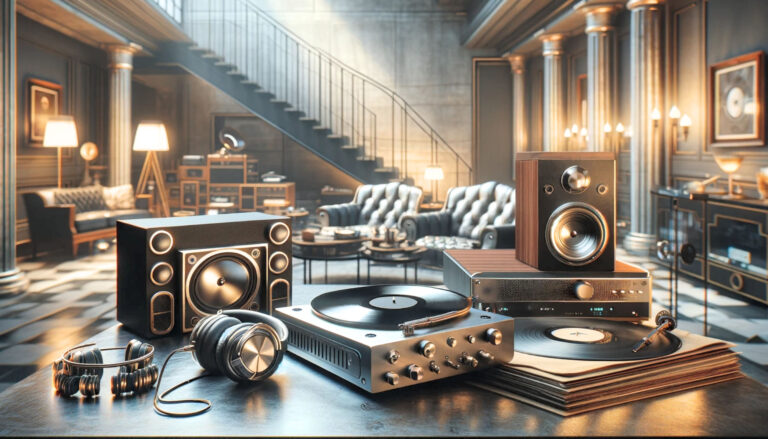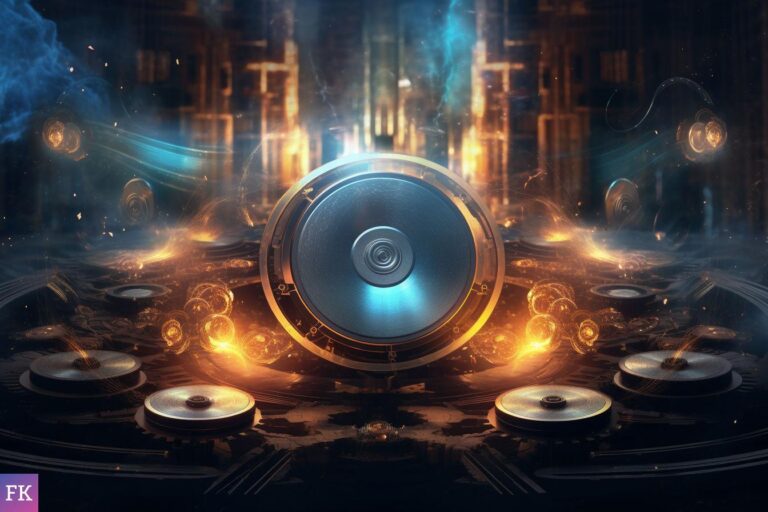3D Audio: Immersive Sound Experiences
🔊 Ready to step into the future of sound? Our latest article explores the revolutionary world of 3D audio! From music and movies to gaming, discover how 3D audio is transforming our listening experiences. 🎧

Welcome to the world of 3D Audio. It’s a new type of sound technology that’s changing how we hear things. Unlike regular stereo or surround sound, 3D Audio feels more real. It makes you feel like you’re right in the middle of the sound.
Imagine being in a forest. With 3D Audio, you can hear the leaves rustling all around you. Or think about being at a concert. You can hear the crowd roaring from different directions. Even in video games, you can hear the sound of footsteps coming closer.
The goal of 3D Audio is to make our experiences with music, movies, games, and virtual reality better. It does this by making sound more real and exciting. So, get ready to learn more about 3D Audio and how it’s changing the way we hear things.

How 3D Audio Works
Have you ever wondered how 3D audio works? It’s all about making sound feel real and lifelike.
Let’s break it down.
First, let’s talk about something called binaural Audio. This is a way of recording sound that uses two microphones. These microphones are placed like human ears. This way, they capture sound just like our ears would. When we listen to these recordings, our brain thinks the sounds are coming from different directions because the sound reaches each ear at slightly different times, just like in real life.
But there’s more to 3D Audio than just binaural recording. There are other tools and tricks that help make the sound feel even more real.
One of these tools is something called a Head-Related Transfer Function, or HRTF for short. This is a fancy way of saying that the shape of our ears, head, and body can change the way we hear sound. By using HRTFs, 3D Audio can mimic these changes and make the sound feel like it’s coming from a specific place.
Another trick is treating sounds like objects. In 3D Audio, each sound is like an object that can be moved around. This way, the sound can come from any direction, just like in real life.
So, in simple terms, 3D audio works by copying the way we hear sounds in real life. It uses special recording techniques, tools like HRTFs, and treats sounds like objects that can be moved around. All of this comes together to create a sound experience that feels like it’s all around you.

The Impact of 3D Audio on Music, Movies, and Gaming
3D Audio is changing the way we enjoy music, movies, and games. Let’s look at some examples.
In music, it can make it feel like you’re at a live concert. For example, in the song “Stairway to Heaven” by Led Zeppelin, it could feel like the guitar is playing to your right, the drums are behind you, and Robert Plant’s voice is coming from the front. It’s like being surrounded by the band!
In movies, it adds to the story. Take the movie “Gravity”, for example. In one scene, Sandra Bullock’s character is spinning in space. With 3D Audio, you can hear her panicked breaths circling around you, making you feel like you’re spinning with her.
In video games, it can make gameplay better. In the game “Fortnite”, you can hear the sounds of footsteps or gunfire from the direction of the action. This can help you figure out where your enemies are, giving you an edge in the game.
Now, let’s compare it to traditional stereo sound or surround sound.
Comparison of 3D Audio with Traditional Audio
When it comes to understanding the magic of 3D Audio, it’s helpful to compare it with traditional audio systems. Let’s look at how 3D Audio stands out from stereo and surround sound.
Stereo Sound vs 3D Audio
Stereo sound is the most basic form of Audio we tend to encounter these days. It involves:
- Two channels of Audio: one for the left speaker and one for the right.
- Sound can only come from two directions: left or right.
On the other hand, 3D Audio:
- It can create sound from any direction, not just left or right.
- Gives a sense of depth and distance, making the sound feel closer or farther away.
Surround Sound vs 3D Audio
Surround sound is a step up from stereo sound. It involves:
- Multiple speakers were placed around the room.
- Sound could come from several directions, but typically not from above or below.
In contrast, 3D Audio:
- Can create sound from any direction, including above and below.
- Provides a more immersive and realistic sound experience.
While stereo and surround sound have their merits, 3D Audio takes the listening experience to a whole new level. It’s not just about hearing sound; it’s about experiencing it in a three-dimensional space. Whether you’re listening to music, watching a movie, or playing a game, 3D Audio brings a level of realism and immersion that traditional audio systems can’t match.

Exploring Current 3D Audio Technologies and Products
The world of 3D Audio is full of exciting technologies and products. Let’s take a look at some of them.
3D Surround Sound Systems
These systems use multiple speakers around the room to create a 3D sound experience. They’re great for home theatres and gaming setups.
3D Headphones
These headphones use special technology to create a 3D sound experience. They’re perfect for personal use, whether listening to music, watching movies, or gaming.
3D Audiobooks
Some audiobooks now use 3D Audio to make the story more immersive. It’s like being in the middle of the story!
Smart Devices with 3D Audio
Many smartphones and tablets now support 3D Audio. You can enjoy the 3D sound with just your device and a pair of headphones.
Shopping for 3D Audio Equipment
If you’re interested in 3D Audio, here are some things to consider when shopping:
- Compatibility: Make sure the product is compatible with your existing devices.
- Quality: Look for products from reputable brands. They’re more likely to provide a good 3D sound experience.
- Reviews: Check out reviews from other customers. They can give you an idea of what to expect.
Some popular brands for 3D audio equipment include Sony, Bose, and Sennheiser. They offer a range of products, from 3D headphones to surround sound systems.
Challenges and Limitations of 3D Audio
While it offers an exciting leap forward in sound technology, it’s not without its challenges and limitations. Let’s explore some of these.
For Users
- Equipment Requirements: To fully enjoy 3D Audio, you need the right equipment. This can include special headphones or multiple speakers. Not everyone has access to these.
- Variation in Experience: Everyone’s ears are different. This means that how we experience it can vary from person to person.
For Creators
- Complex Production: Creating 3D Audio is more complex than traditional Audio. It requires special recording techniques and sound design. Time is not a luxury for all.
- Lack of Standards: No standard exists for creating or playing it. This can make it challenging for creators to produce sound that works well on all devices.
Despite these challenges, the potential is huge. As technology advances, we can expect to see solutions to these issues. In the meantime, whether you’re a user or a creator, there’s plenty to explore and enjoy in the world of 3D Audio.
Market Analysis
The global 3D audio market is expected to grow at a CAGR of 16.4% from 2021 to 2028, reaching a value of USD 12.97 billion by 2028. The increasing demand for 3D Audio in home cinema, gaming, and the music industry drives this growth.
Leading Companies:
Some of the key players in the 3D audio market include Dolby Laboratories, DTS, Inc (Xperi Holding Corporation), Hooke Audio, Auro Technologies Inc., and 3D Sound Labs. These companies have a significant market share due to their wide range of products and services, continuous product innovation, and focus on building partnerships with other players in the market.
Consumer Adoption Trends:
The adoption of 3D audio technology is increasing rapidly due to its immersive sound experience. This technology is being widely used in various applications such as VR/AR, gaming, cinemas, and music. The increasing popularity of VR/AR games and movies that provide a 3D sound experience is one of the major factors driving the adoption of this technology.
Regional Analysis:
North America holds the largest market share due to the presence of major market players and high adoption of advanced technologies. However, Asia-Pacific is expected to grow at the highest CAGR during the forecast period due to the increasing adoption of VR/AR technologies and growing entertainment industry in this region.
Future Trends:
The future of the 3D audio market looks promising with the development of new technologies such as spatial Audio, which provides a more immersive sound experience. The integration of AI with 3D Audio is another trend that is expected to drive the market growth in the future. Moreover, the increasing use of 3D Audio in autonomous vehicles for creating an immersive in-car experience is also expected to provide growth opportunities for the market players.
Please note that this information is based on the latest available data and the actual market conditions may vary.
Here are the sources used for the market analysis section:
- Grand View Research: 3D Audio Market Size, Share & Trends Analysis Report By Component, By End Use, By Region, And Segment Forecasts, 2021 – 2028
- MarketWatch: 3D Audio Market Size 2021
- GlobeNewswire: 3D Audio Market Research Report by Component, by End User – Global Forecast to 2025 – Cumulative Impact of COVID-19
- TechSci Research: Global 3D Audio Market By Component, By End User, By Region, Competition Forecast & Opportunities, 2012 – 2022
Please note that the information provided is a summary and interpretation of the data from these sources. For more detailed information, please refer to the original sources.

Future Trends in 3D Audio
The future of 3D Audio is promising, with advancements and new applications on the horizon. Here are some key trends and predictions:
- Market Growth:
- The global 3D audio market is expected to grow at a significant rate. According to a report by MarketWatch, the market is projected to grow at a booming CAGR from 2023 to 2030, rising from USD billion in 2023 to USD billion in 2030. Key players in the sector include OSSIC, 3D Sound Labs, Comhear Inc., Dolby Labs, Auro Technologies Inc, DTS, Dysonics, Hooke Audio, Waves Audio Ltd., and Sennheiser electronic GmbH & Co.
- Increasing Demand:
- Consumers are seeking more immersive and realistic audio experiences, driving the demand for 3D Audio in various applications such as gaming, movies, and music. The ability to create a sense of presence and transport listeners into virtual worlds is also a significant driving factor. The global 3D audio market is poised to surpass US$ 7.77 billion by 2023, surging at a remarkable CAGR of 13.3% through 2033 to reach US$ 14.75 billion, as per a report by Future Market Insights.
- Technological Advancements:
- Exponential growth is evident in 3D audio technology, as companies are investing in research and development to provide a next-generation audio experience which leads to broader technological advancement in 3D Audio. These factors are projected to accelerate the demand for the market during the year 2023 to 2033 with a projected CAGR of 13.3%.
- Applications in Various Industries:
- 3D audio products have a wide range of applications including automobiles, media, and entertainment, gaming among others. These are constantly multiplying over time, catering to the expansion of the 3D audio market size.
These trends suggest that 3D Audio will continue to evolve, overcoming current limitations and opening up new possibilities. The increasing demand for immersive audio experiences, advancements in technology, and the application of 3D Audio in various industries are all factors contributing to the growth of the 3D audio market.
Conclusion
3D Audio is not just a technological innovation; it’s a revolution in the way we experience sound. It’s about creating a sense of presence, transporting listeners into virtual worlds, and enhancing our experiences with music, movies, games, and more.
The potential of 3D Audio is immense. As we’ve seen, it’s transforming industries, from entertainment to automotive, and its growth shows no signs of slowing down. With advancements in technology and increasing consumer demand for immersive audio experiences, the future of 3D Audio looks bright.
But the story of 3D Audio is just beginning. There are still many possibilities to explore, from new applications to technological advancements that could further enhance the 3D audio experience. As consumers, creators, and technologists, we have the opportunity to shape this future.
So, we encourage you to embrace the possibilities of 3D Audio. Whether you’re a music lover, a movie buff, a gamer, or just someone who appreciates good sound, 3D Audio has something to offer you. It’s more than just a new way of listening—it’s a new way of experiencing the world. And as we continue to explore and innovate, we can look forward to a future filled with rich, immersive sound experiences.





